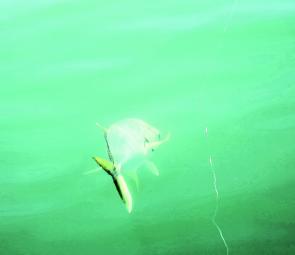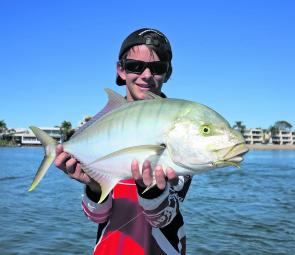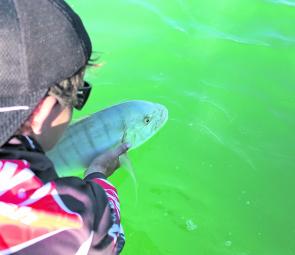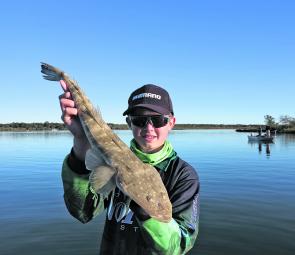Over the years fishing for smaller estuary trevally has become more and more popular, but so has fishing for those monster trevally that prowl the waters of our open oceans and around cliff faces. This popularity is due to their power, speed and strength once hooked, and it’s why people like us go back for more and never give up.
As the afternoons start to get cooler, it means one thing: the trevally aren’t too far away. Trevally enjoy the cooler water temperatures because crustaceans like prawns start to run and spawn. When the prawns are pushed down to the lower parts of an estuary by rain and tides, the trevally take advantage and feed heavily on them. It doesn’t take long for a school of trevally to locate and destroy a school of prawns.
Over the last couple of years I have found trevally to be an awesome sportfish to target in the rivers because, for their size, they are such a powerful and strong fish and will not give up. Trevally often swim in schools so you are able to hook more than one from a school, which makes it even more fun. At times, if you drop one, you can hook another in the same school as they are an aggressive predatory fish when feeding.
Fishing for trevally isn’t always easy because trevally are a pelagic species and they move around a lot when searching for food. That’s why fishing the right tides is so important for targeting these speedsters in the rivers. I find the best tide to fish for trevally is either the start of the run-out or the start of the run-in tide.
With the first of the run-in tide, bigger baitfish like gar mullet swim through the mouths of our rivers. The trevally follow and chase those bigger sized baits towards the surface. I try not to fish for trevally during the middle of the tides because trevally will normally feed themselves up at the start and even the end of the low or high tide.
Trevally are a fish that will feed right throughout the day, but are more active during the low light hours of the morning and afternoon or even during those cold winter nights. Trevally feed in this pattern because baitfish struggle to adjust to the changing light conditions, leaving them vulnerable to attack. To get the best out of a morning or an afternoon session try coupling a low light period of the day with a tidal change, such as a high to a low tide (run-out tide).
When talking about the gear to use for trevally, some people think heavy gear because trevally can grow to excessive sizes. Some can reach the 60kg mark, which is a monster fish to hook and try to land.
However, when you’re fishing the river systems the trevally are much smaller. Most of the ones you’ll catch will be around 40-60cm. At that size they’re still great sport on light gear (but not on heavy gear).
When talking light gear I mean using a graphite rod in the 7’ range and 1-3kg or 2-4kg. The reel size is important as well as you don’t want a big reel like a 4000 on a 1-3kg graphite rod. Using a reel around the 1000-2500 size will be perfect for targeting those estuary trevally.
Talking line is also important. Braid is a must because it has no stretch, allowing you to feel every little hit and bump. Running braided line around the 4-6lb rating is perfect for this type of fishing. I also highly recommend using a fluorocarbon leader ranging from 4-8lb because fluorocarbon is a lot harder of the fish to see than monofilament is. Following these simple techniques will increase your catch rate, as the lighter the line the more fish you will successfully land.
Using lures and plastics for trevally is all about matching the hatch on the day. If you’re throwing a 3.5’’ plastic or trolling a 100mm hardbody and the trevally are feeding on 2” bait, you won’t have much success.
Minnow style and paddle tail soft plastics work well on estuary trevally. The minnow’s flicking action imitates a prawn, and the paddle tail works well when the fish are down deep and that little bit of vibration will at times get them to feed.
Some of the most common soft plastics I use are the 3” Berkley PowerBaits in watermelon pearl and cast clear colour, 2” Berkley Gulp Shrimp in banana prawn and pepper prawn colour, Gladiator Prawns in gold fleck colour and Izumi Gastronomic paddle tail 3.5” in 02 and 07 colour.
Jighead selection is also important when fishing for trevally because the lighter the weight the more natural the plastic will look on the sink. Some of my favourites in the TT jighead range are 1/12H 1/0, 1/8H 3/0, 1/6H 2/0 and 1/4H 3/0. Looking at the profile of your soft plastic is also important when it comes to selecting a jighead. If you’re using a little 2” plastic in 4m of water you would run something like a 1/12H 1/0. A bigger jighead like (say) a 1/4H 3/0 would definitely not look natural.
The techniques I find that work for trevally are a simple slow roll, two hops off the bottom, darting your rod constantly until your lure is back to the boat (minnow-styled plastics) and a simple vibration to the rod tip. These techniques all work, but how long you rest it on the bottom may vary depending on their feeding patterns.
When it comes to hardbodies, lures that get down to the bottom and also those which will swim in the middle of the water column work best. I sound a lot of my bait on my sounder either on the bottom or mid water.
Hardbodies I like to use when trolling for trevally are Ecogear SX60 in 333 and 394, Strada Tracka 100mm in col marilynne colour and Zipbait Trickshads 70mm in 298 and 309. I usually troll lures around 3 to 6 knots depending on how the fish are feeding on the day.
I hope this article has helped you guys to catch some trevally, and all the gear I’ve mentioned is available at most tackle stores, including here at Davo’s Tackleworld Noosaville. Tight lines and singing drags from Mitchel Fredericks.
Reads: 3772
Trevally enjoy cooler water temperatures.

These fish have a powerful forked tail and give a good account of themselves.

One of several good fish caught during a session on the canals.

A trevor destined for release.

Flathead are a common bycatch when targeting trevally in the estuaries and rivers.




